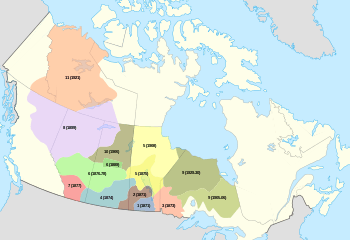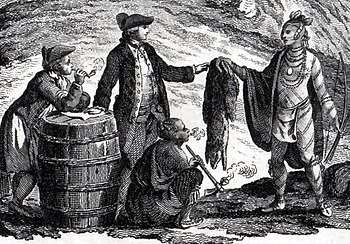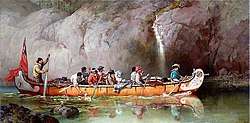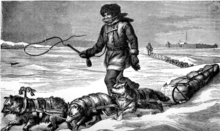Michel Band
The Michel Band, or formerly, The Michel First Nation, is an Indigenous group of people located central Alberta, Canada. Named after the first elected council Chief, Michel Callihoo, the band officially signed Treaty Number 6 by adhesion on September 3 of 1878. The Michel First Nation is composed primarily of Iroquois, Cree and Métis with over 700 current registered descendants.[1]

The Michel Reserve #132 was once located near the present-day town site of Villenevue, Alberta, described and surveyed in September 1880 by G.A. Simpson; "to a post on the right bank of the Sturgeon River and thence easterly along the said bank of the river to the point of beginning, containing an area of forty square miles more or less."[2]
The entire band was illegally enfranchised by the Canadian Government on March 31, 1958 by Order in Council P.C. 375. The Michel First Nation is the only band in Canada during the 20th Century to be enfranchised.[1]
Iroquois History
The Michel Band emerged as a distinct cultural and kinship group during the Canadian Fur Trade, traveling west from the Catholic Iroquois communities of Caughnawaga and St.Regis. Generations of Iroquois had been trapping furs for a living and had become relatively dependent on trade goods to maintain a comfortable lifestyle in the St.Lawrence River and Great Lakes regions.[1]

Prior to their divergence as distinct Catholic communities, most Iroquois were politically governed by the traditional customs and governance of the Great Law of Peace. In 1645 Iroquois headmen began treating the Frenchmen of Trois-Rivières, the Hurons, and Algonquins. In their dealings with the French, Iroquois diplomats adapted the language and rituals of the Great Law of Peace to create the protocol for intercultural diplomacy.[3] In 1654, Daniel Garakontie or "The Moving Sun" was the Great Sachem of the Iroquois Confederacy.
"Five whole Nations address thee through my mouth. I have in my heart the sentiments of all the Iroquois Nations - and my tongue is faithful to my heart." -Garakontie[4]
Garakontie was known as Sagochiendagehte ("the name bearer") the Council name of the Onondaga - a status he occupied as its principal speaker. Garakontie was his family name and not his hereditary title, thus his status as speaker and chief diplomat was achieved, not ascribed by his membership into the Bear Clan.[5] The first references to Garakontié reveal him struggling to preserve the general peace of 1653.[6]
While in Quebec Garakontie proclaimed his faith in Christianity.[5] Garakontié was baptized in the Cathedral of Quebec.[6] He announced he would no longer sponsor dream feasts and declared the Iroquois cosmology was a fable.[4] Traditionalist Iroquois headmen maintained that Garakontie had become French and untrustworthy[5] The Jesuits had not only created Catholic converts, but also strong Christian and Traditionalist factions that brought unprecedented disquiet to Iroquois communities.[7]
By the late 1660s Jesuit missionaries encouraged increasing numbers of Catholic Iroquois to desert their homes for the mission villages in Canada; by the mid 1670s over two-hundred had departed. The lack of pelts to trade and warfare created serious economic hardship in Iroquoia. In 1700, over 500 of their 2000 warriors had been killed, captured, or had deserted to Catholic missions.[7]
Louis Kwarakwante

Louis Kwarakwante ("The Sun Traveller") was born in 1782 near the Catholic Mission of Saul St. Louis of Caughnawaga.[8] It is speculated that Louis was Mohawk. The name Kwarakwante appears to be an incorrect translation of Garakontie. Records list his surname variously as "Karaconti. Karaquienthe, Caraquanti." Louis also went by the surname of Callihoo, which derived from "Karhioo" meaning "Tall Forest" in Iroquois. Many members of his family, especially those who went west with the Fur Trade, had the name Karakontie bestowed on them by the clergy. Louis Kwarakwante was likely a grandson of Daniel Garakontie.[1]

As early as 1800, the North West Company began to employ Iroquois voyagers. Colin Robertson said he preferred the Iroquois voyageurs to French-Canadians in a rapid or dangerous river crossing "for their calmness and presence of mind which never forsakes them in the greatest danger." [1] This was still a common trend even up until 1872, when George Grant remarked:
"Our crews were chiefly Iroquois Indians from Caugh-naw-aga, near Montreal, the best voyagers known, according to the testimony of everyone who has tried them. The Iroquois made the engagement for the trip, and hired a few Ojibways bear the Shebandowan and Fort Francis to make up the necessary number. They were as fine-looking, clean-limbed men as one's eye could desire to rest on, punctual, diligent, uncomplaining, and reserving their chief affection for their canoes. As a jockey cherishes his horse and shepherd his dog, so do they care for their canoe." [9]
The NWC undoubtedly hired Iroquois from Caughnawaga not only for their experience, but also their familiarity with the Catholic clergy and the habitant seigneuries who had land holdings in the Missions. The Regardless, the bark longhouses still resembled those of in Mohawk Valley, and traditional agriculture was still practiced. In this Mission, Louis Callihoo learned his catechism and his prayers in his native tongue. He spoke French and later many other languages as well, which no doubt made his commercial dealings easier. He was contracted as a canoemen on November 23, 1800 by McTavish, Frobisher & Company, agents of the NWC.
Iroquois Freeman


References
- Macpherson, Elizabeth (1998). The Sun Traveller. St.Albert, Alberta: Musée Héritage Museum. p. 6.
- MacPherson, Elizabeth (1998). The Sun Traveller. St.Albert, Alberta: Musée Héritage Museum. p. 56.
- Richter, Daniel K. (November 1, 2010). Beyond the Covenant Chain: The Iroquois and Their Neighbors in Indian North America, 1600-1800. Penn State Press. p. 22.
- Jesuits (1896). Jesuit Relations. Cleveland: Burrows Bros. Co. pp. 53:45.
- Fenton, William Nelson (1998). The Great Law and the Longhouse: A Political History of the Iroquois Confederacy. University of Oklahoma. p. 285.
- "Daniel Garakontie". Dictionary of Canadian Biography.
- Hackett, David G. (2003). Religion and American Culture: A Reader. Psychology Press. p. 64.
- Morin, Gail (2019). Company Men: Louis Callihoo. Gail Morin. p. 1.
- George, Grant (1968). By Canoe From Toronto To Fort Edmonton in 1872: Among The Iroquois and Ojibways with a chapter on Winter in Canada. Toronto: Canadiana House Toronto.